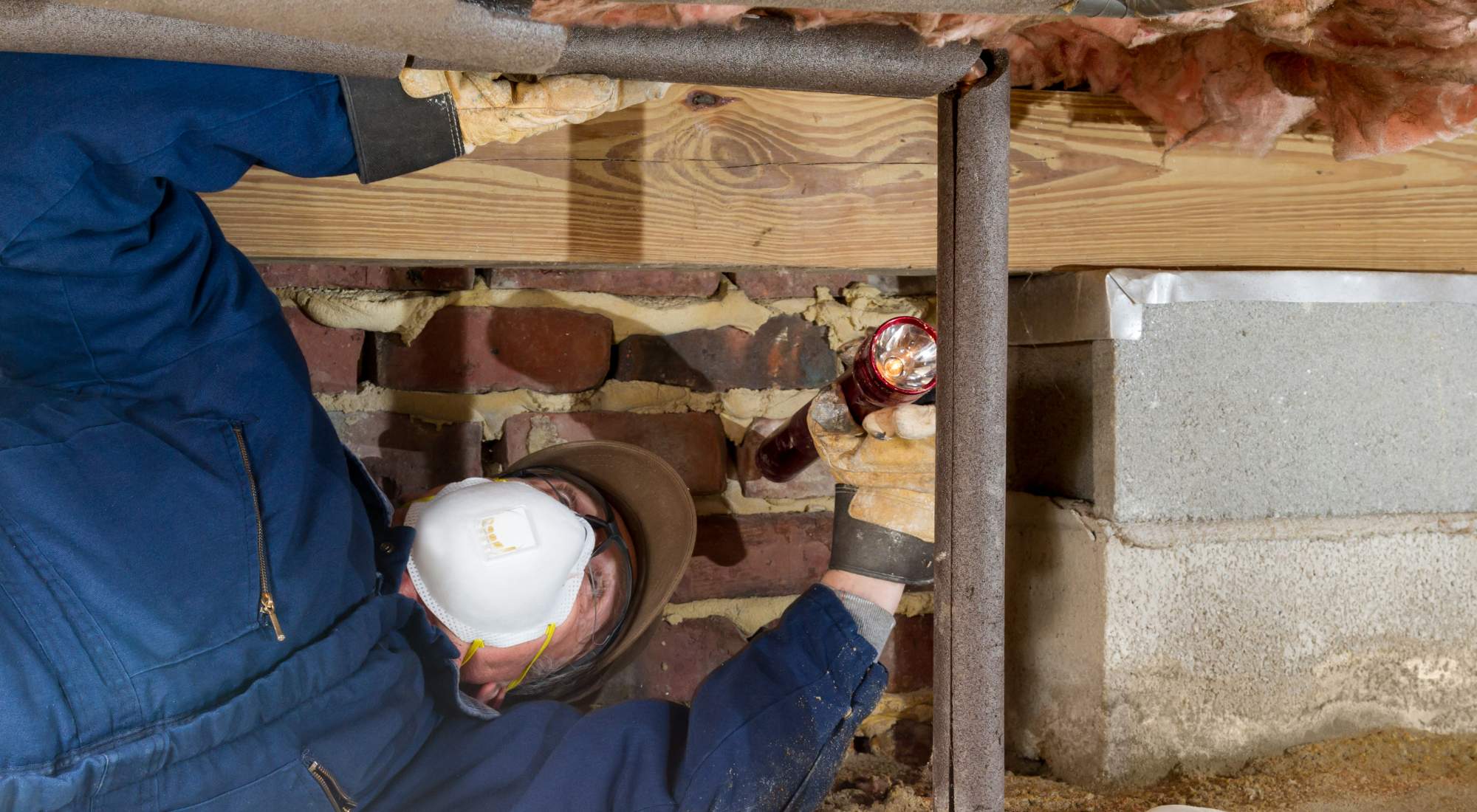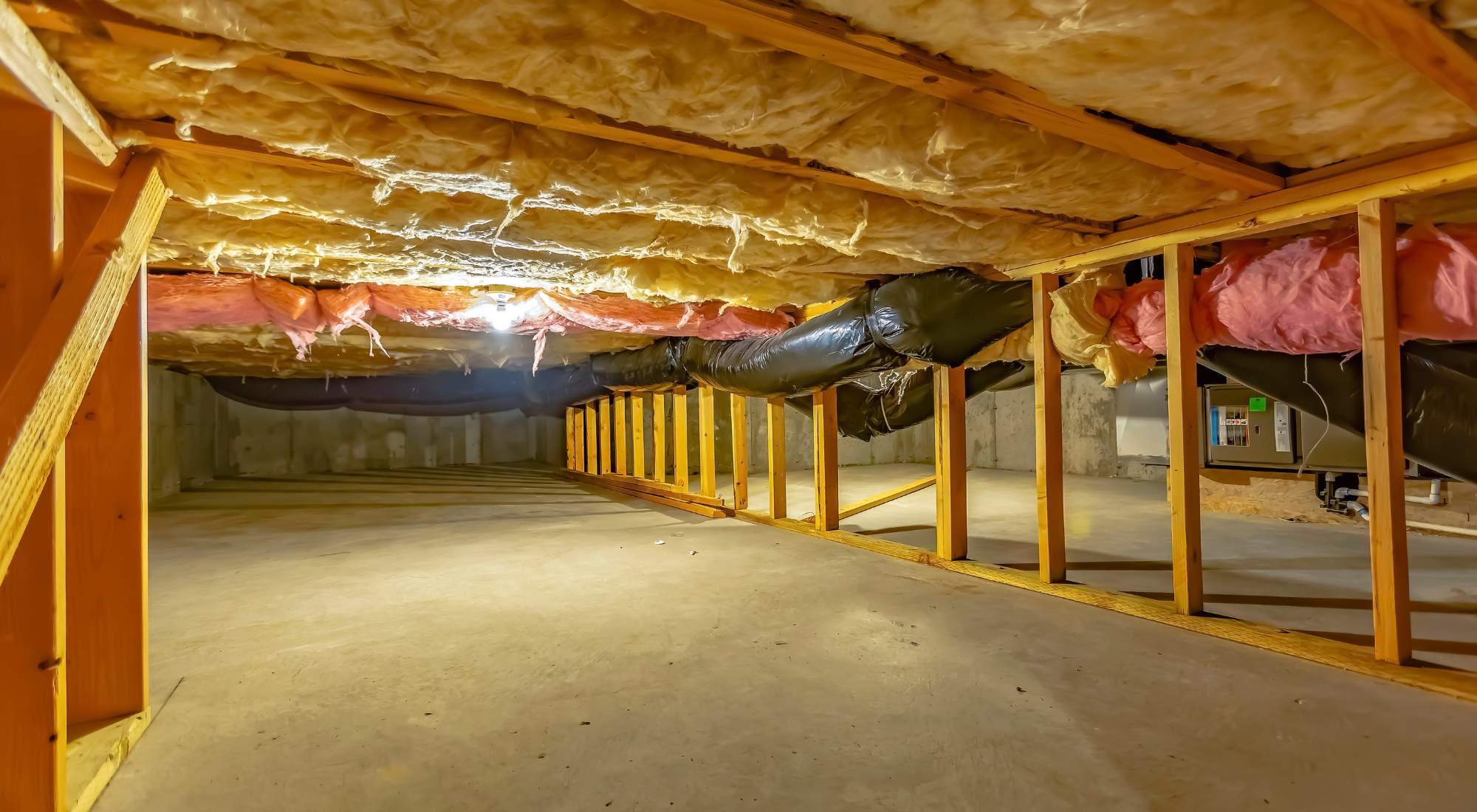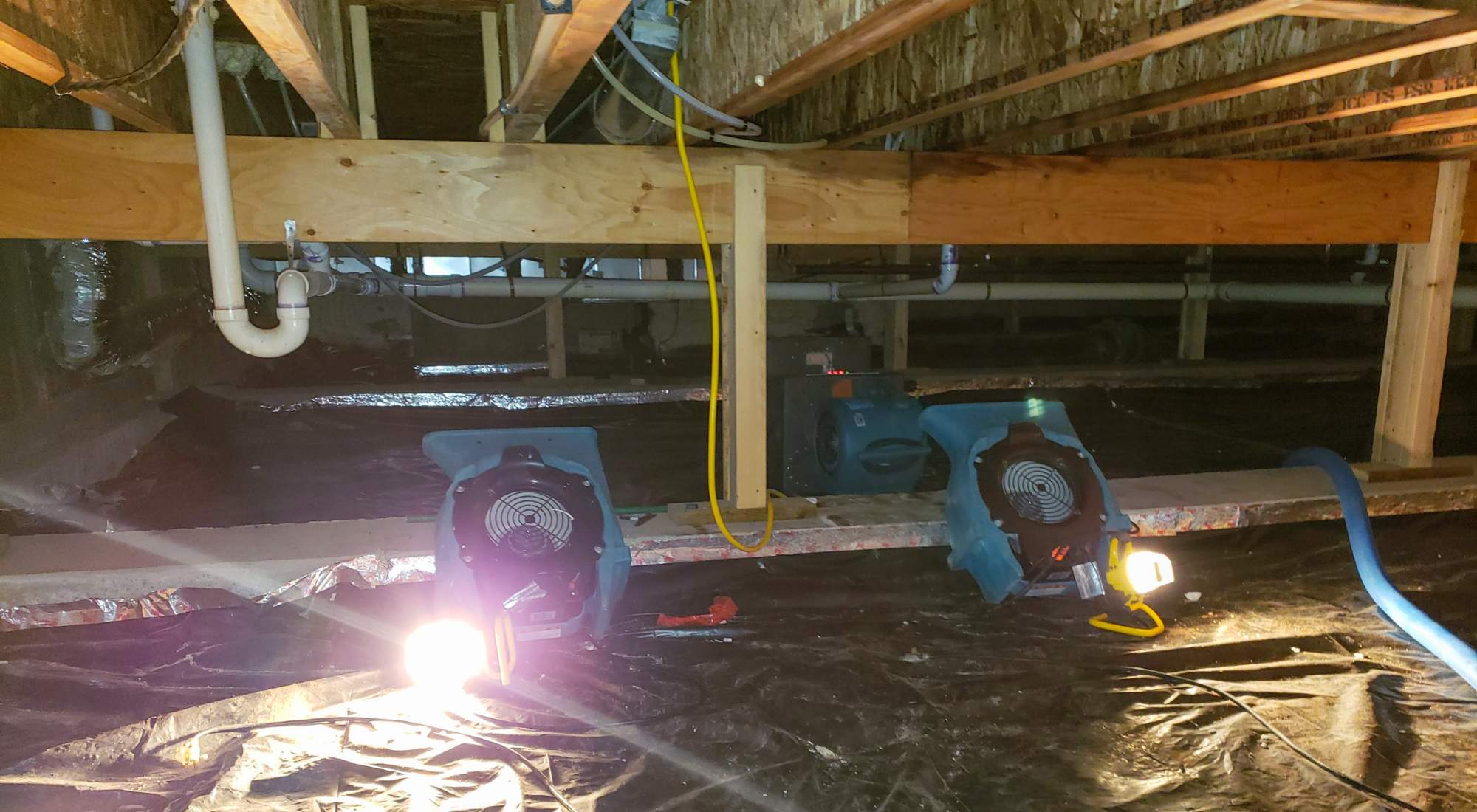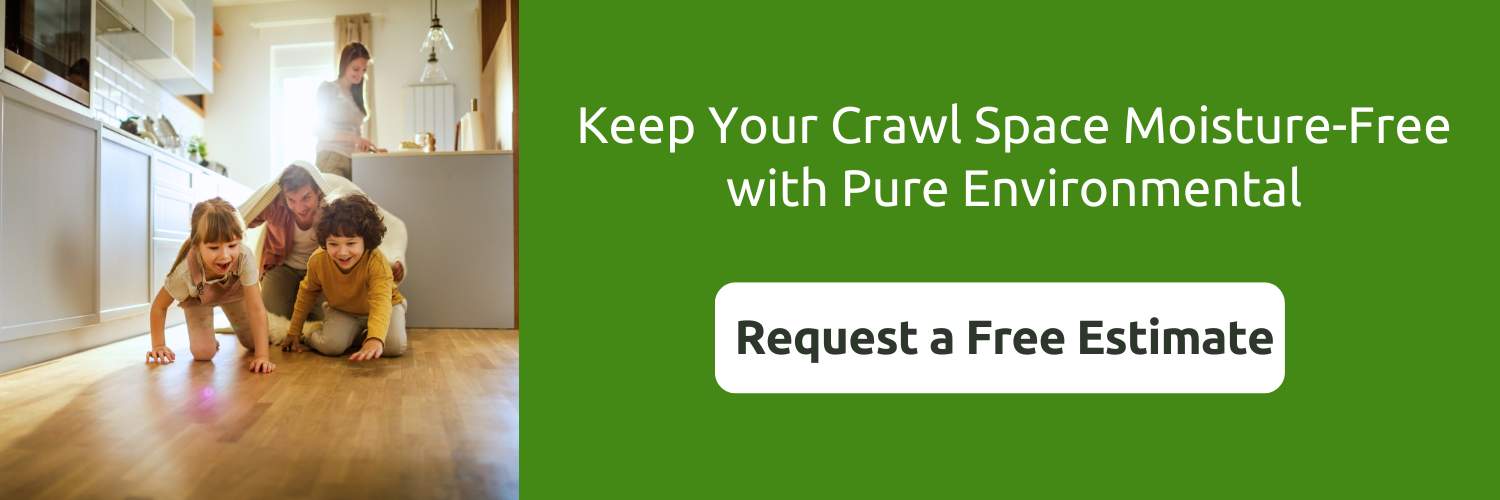Do you have water accumulation in your crawl space? Has a busted pipe caused water damage? Are musty smells coming from beneath your floors or the sides of your house?
Let’s be honest, who wants to get down in a wet, funky crawl space to figure out what’s wrong? You’re probably unsure of what to look for or how to fix the problem, anyway.
Luckily, professional help is available. We will discuss common signs and causes of crawl space issues, preventative measures to keep your crawl space dry, and where to get help when you need it.
Table of Contents
- 7 Common Causes of Crawl Space Water Issues
- How Do I Stop Water From Coming in My Crawl Space?
- 7 Preventative Measures That Can Keep Your Crawl Space Dry
- Stay Dry With Pure Environmental’s Routine Crawl Space Maintenance

7 Common Causes of Crawl Space Water Issues
Water and moisture in your crawl space can happen for many reasons. If you notice water, moisture, or musty smells in your crawl space or anywhere else in your home, Pure Environmental can help.
Contact us today to schedule a visit, where we will assess the situation and come up with the best plan of action to remediate it.
#1: Insufficient Water Drainage
If the ground slopes toward your house, it can cause water to accumulate in the crawl space. Pay attention if there seems to be a slope in your yard and water is collecting near your house or in your crawl space.
If you notice that the water is coming down from your roof and then not draining properly, you may have clogged gutters or another issue with your gutter system.
In either case, your best bet is to consult with a professional team that can mitigate any damage already done and create a plan to prevent future problems.
#2: Heavy Rainfall and High Groundwater
If you live in an area that gets a lot of rain or experiences a particularly heavy rain, it may cause water to collect or seep into your crawl space. Any time water stands in your crawl space, it can lead to problems with mold, rot, odors, and other issues resulting from water damage.
#3: Plumbing Leaks
This is often one of the most common reasons that water ends up in your crawl space — there is a leak in your home that you aren’t aware of until the water damage or accumulation gives it away. Most leaks happen beneath your floors or behind your walls. When this happens, there are often no initial visual indicators of the problem.
Unfortunately, this can mean that by the time the leak is discovered, there might be extensive water damage.
Water damage can impact the:
- Crawl space
- Subflooring
- Flooring
- Walls
- Ceilings
- Foundation
Always be on the lookout for standing water in your crawl space and around the exterior of your house, as well as water damage to the walls, floors, and ceilings. If you do not know where it is coming from, it could be a busted pipe above ground, below ground, or behind walls. It is wise to get a professional in ASAP to assess where the water is coming from.
Ask your trusted environmental professional or plumber about smart valves to catch any plumbing leaks early.
#4: Nearby Landscaping Water Sources
Sometimes, landscaping features and additions can direct water toward the foundation of your home instead of away from it.
Be aware of the placement of:
- Sprinklers
- Flower beds
- Improperly placed drainage features
A landscaper, or you if you do your own landscaping, should measure slopes on your property and the flow of groundwater, given environmental factors where you live.
#5: Temperature Condensation
When warm air hits a cool surface, it can cause condensation to form, especially on things like pipes and ductwork underneath your home, and concrete walls in basements.
If the temperature difference is drastic, the amount of condensation could become a problem, causing water damage and excess moisture in your crawl space.
#6: Cracked Foundations and Walls
Small cracks in the walls of your home and/or the foundation can allow water to seep in over time, especially after heavy rains. If you observe water in your crawl space and aren’t sure where it is coming from, get a professional to see if cracks might be the cause.
#7: Faulty Equipment or Improper Installation
Faulty equipment or improper installations could cause issues with moisture and water damage under your home, including:
- Broken sump pumps
- Components of the HVAC system
- Improperly installed vapor barriers
- Improperly installed encapsulation systems
Each of these requires routine maintenance to function properly and to catch issues or early.

How Do I Stop Water From Coming in My Crawl Space?
The best way to stop water from entering or collecting in your crawl space is to use preventative measures to keep it from getting there in the first place. It’s much easier to avoid this situation than it is to mitigate it once it’s a problem.
Not to worry, if you are experiencing a problem with moisture and water accumulation in your crawl space already, professional help is available. Pure Environmental offers comprehensive professional services to Portland and the surrounding area.
A quality team, like Pure Environmental will:
- Pinpoint the source
- Mitigate any damage
- Recommend and utilize preventative measures to avoid future issues with water damage in your crawl space
7 Preventative Measures That Can Keep Your Crawl Space Dry
#1: Proper Grading and Drainage
Landscaping is one area where improvements or modifications to your property can prevent issues with water in your crawl space.
Here are a few considerations involving landscaping around your home:
- Make sure the ground slopes away from the foundation.
- Use gravel and native plants to absorb moisture.
- Measure the slopes and install a drainage ditch if needed.
#2: Gutter and Downspout Maintenance
There are several ways to improve the condition of and maintain fully functional gutters. Here are some possible solutions if you have a problem involving gutters, downspouts, and drainage:
- Deep clean gutters and downspouts of leaves and debris.
- Install French drains.
- Extend downspouts to prevent moisture from collecting in the crawl space.
#3: Install a Vapor Barrier
A vapor barrier is a thin layer of impermeable material, often polyethylene sheeting, included in building construction to prevent moisture from damaging the building. This can be installed during new construction or added to a home at any time.
It is important to consult a professional to assist with installing a vapor barrier in order to:
- Choose the right material based on environmental factors
- Pick the right thickness of sheeting
- Ensure proper installation
- Determine if other measures are needed to keep the crawlspace dry
Pure Environmental offers both vapor barrier services and water damage mitigation services.
#4: Proper Ventilation and Dehumidification
Crawl spaces can be either vented or sealed. Ventilation may help with moisture buildup in crawl spaces, but it can also increase moisture in some instances.
Vented crawl spaces:
- Are designed with openings to allow for air circulation.
- Aim to prevent moisture buildup and connected issues like mold and rot.
- May increase moisture in humid climates.
- Sometimes allows water to intrude through the vents.
Sealed crawl spaces:
- Are also known as encapsulated crawl spaces.
- Seal all vents, doors, and other openings.
- Include a moisture barrier on the floor and walls, and insulation to create a dry, clean, and energy-efficient space.
- If moisture finds its way into an encapsulated crawlspace, it typically has no way to exit on its own.

#5: Crawl Space Encapsulation
Crawl space encapsulation, as described above, can be very effective in preventing water buildup and related water damage issues.
This is not an easy DIY project. Improperly installed encapsulation, or encapsulation installed without conducting a thorough, professional survey of the crawl space, may lead to costly damage down the line.
Do yourself a favor: Hire a reputable company to assess your crawl space, make recommendations, and do the work. Pure Environmental is prepared to provide guidance, make recommendations, and install encapsulation across the Greater Portland area.
#6: Install a Sump Pump
Sump pumps may not always be necessary, but there are certain times when it is important to install one to maintain a dry crawl space.
A sump pump is a device, sometimes submersible, installed in a sump pit (a hole dug in the lowest part of a basement or crawlspace) to remove accumulated water, preventing flooding and water damage.
An environmental specialist can assess whether a sump pump is needed in your house. Here are situations where a sump pump is likely to be recommended:
- Areas with high water tables or heavy rainfall.
- Homes with basements or crawl spaces below the water table.
- Homes with poorly draining soil.
#7: Find and Fix Plumbing Leaks
To inspect pipes for leaks and condensation, check ceilings, walls, and flooring for signs like:
- Wet spots
- Water stains
- Mold
- Musty odors
- Paint separation
- Buckled wood
If you observe a potential leak, you may consider using a water meter test or a dye test to pinpoint the source. Small plumbing leaks may be a DIY fix, while larger or less accessible leaks will likely require professional assistance.
Stay Dry With Pure Environmental’s Routine Crawl Space Maintenance
Routine maintenance can prevent water accumulation and damage to your crawl space. Installing sump pumps, vapor barriers, and encapsulation isn’t just a one-time fix — crawl spaces still need regular maintenance to stay dry and find any signs of moisture early.
If you think you have a problem in your crawl space, Pure Environmental offers crawl space cleanup services in Portland and Tacoma.
We also specialize in preventative measures, like encapsulation and sump pump installation, to ensure that you never end up with a costly, messy situation under your house.
We also provide routine maintenance to keep your crawl space dry and your equipment running smoothly. Reach out today to schedule your consultation. We look forward to helping you and your family protect the integrity and safety of your home.
Recent posts
- Maximize Comfort & Savings: Make Your Attic More Energy Efficient Today
- How To Prevent Water in Your Crawl Space: Proven Strategies To Prevent Water Damage
- Fresh and Clean: How To Disinfect the Air in Your Home Naturally
- Pros and Cons of Heat Treatment for Bed Bugs: Things To Consider When Reviewing Your Options for Remediation
- How To Get Rid of Pet Odor in Your House
Recent Posts
- Maximize Comfort & Savings: Make Your Attic More Energy Efficient Today
- How To Prevent Water in Your Crawl Space: Proven Strategies To Prevent Water Damage
- Fresh and Clean: How To Disinfect the Air in Your Home Naturally
- Pros and Cons of Heat Treatment for Bed Bugs: Things To Consider When Reviewing Your Options for Remediation
- How To Get Rid of Pet Odor in Your House
